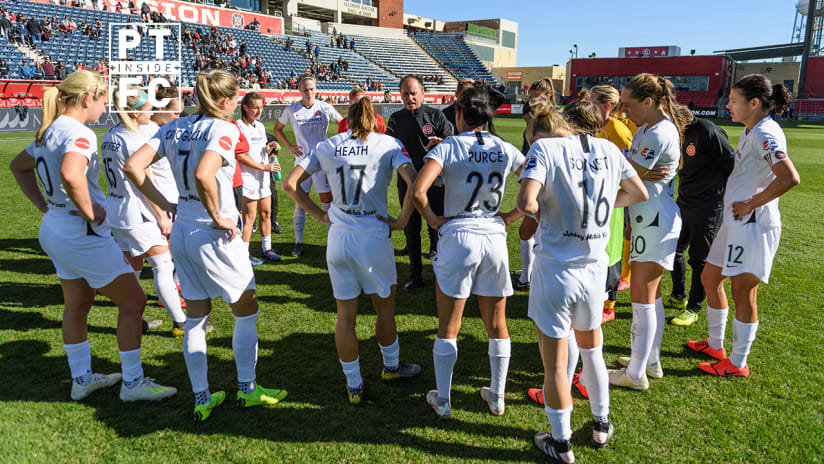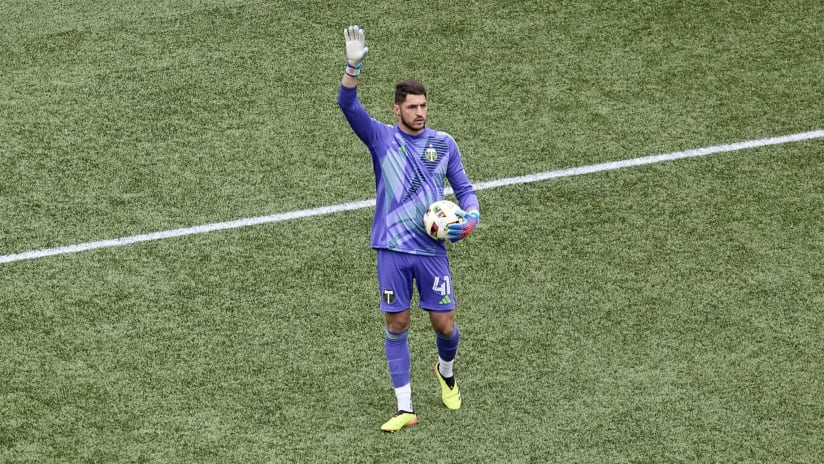“We do simple stuff, we have simple rules.”
For Portland Thorns FC, the principle remains as true now as it was three years ago, when Mark Parsons was explaining his new team’s strong start. He was seven months into the job in Portland, trying to institute a new scheme and culture, and his team had quickly becoming one of the stingiest in the league. A Thorns squad that was known for the elite talents they had in attack began adhering to defense, first.
“We have areas the other team is allowed to go to,” he explained, then. “There are areas they cannot go to. And we just train and (watch) video and talk and train.”
Fast forward three years, and the principles underpinning the Thorns remain the same. When teams get the ball in certain areas, you know something has gone wrong, and while Parsons he never outlined the exact points on the field that are supposed to be verboten, the principle is still important.
For example, consider the places where Portland’s defense allows the ball to get to on this, the Chicago Red Stars’ third goal during Saturday’s 4-4 draw at SeatGeek Stadium.
This is a beautiful play by Chicago, made possible by a collection of players whose technical and tactical acumen is as dangerous as any in the National Women's Soccer League. But it also involves not one but two entry passes into the Thorns’ penalty area, in addition to a third ball that, six yards out, is played across the face for goal.
It’s natural to look at the final moments of any goal and draw conclusions, and to a certain extent, we have to, if we’re going to understand what happened on Saturday to the Thorns. The way highlights are cut leave us with few alternatives, usually only showing the final passes before a score. But for coaches, the entire sequence that led to the shot, the chance, the entry pass and the possession matter, too. It's not only part of each staff’s due diligence, but it’s also why coaches often say it’s more than one mistake that leads to goals. With very rare exceptions, the seeds of goals are planted far away from their bloom, in the moments when attacks are allowed to gain control higher or wider on the field.
All of that ties into the principle Parsons cites, above. The Red Stars got to a place they aren’t allowed to go. How? The emergency defending the team could have done in the movement’s final moments is different issue. How could the ball be kept out of such a dangerous area in the first place?
That view provides a different context to Parsons’ Saturday thoughts. When a coach says “the basics of defending were off,” he could be talking about individual decisions and technique, the group’s organization, or the how players are executing the team’s principles; or, he could be talking about all of the above. When you give up four goals, it’s usually a combination of factors, but on Saturday’s third goal, how Chicago ends up running full speed onto a ball at the edge of the six-yard box has to be a primary concern, in addition to two of the passes that came before.
Still, the Red Stars’ fourth goal may be an even better example of why teams have to be paranoid about penalty-box entries.
By the time Sam Kerr gets into Portland's 18-yard box, she is surrounded by Thorns, who have managed to contain the shot. It’s about all you can expect at that moment, from Portland’s defenders. When the league’s best goal scorer is in that position, you try to make the right decision and hope it works out.
But because Kerr was allowed so deep into the penalty box, the Thorns’ emergency defending ends up working against them. Yes, the players end up preventing the first shot, blocking Kerr’s attempt before it finds its way to goal, but the deflection is beyond their control. And because Kerr had so much gravity as she collapsed Portland's defense, Yuki Nagasato was wide open, like a star circling a black hole, when the rebound fell to her boots.
Even more than Chicago’s third goal, the fourth shows how much control you lose once the ball reaches such a dangerous spot. In this case, Kerr’s attempt fell to a teammate, but it could have been deflected into goal. Maybe her shot finds a Portland defender’s hand, drawing a penalty? Or maybe one of the defenders makes the wrong choice, and ends up taking Kerr down? We should also remember that this is Sam Kerr. She could have just buried the shot.
What happened in the moments that led to the shot? That allowed Kerr to not only find that space in the penalty box but also allowed her teammates to connected with her? Highlights, sometimes, cut those moments out, but when coaches are breaking down film, they’re often just as important. Each spot, no matter how close to goal, is a chance to prevent a scoring opportunity.
Even on Chicago’s first goal – a call that remains in doubt for the broadcast’s lack of replay coverage – you can ask the same questions. How are the Red Stars in a position to play a cross from that spot? Certainly, there are more dangerous spots to build play from on a soccer field, but what happened higher up the pitch that left Ellie Carpenter chasing to prevent a byline cross?
“Our defending is a journey …,” Parsons conceded this weekend, a vague allusion to the improvement he’s hoping to see from 2018’s defensive returns. “It’s going to be a journey to get those things right. Get them right enough week to week, in order to win games, and get them right when they need to be, in the most important part of the season.”
In that sense, there is still a long way to go. It’s week three, now. The Thorns will play at least 24 games. How the team’s defending at the moment is far less important than how it will be defending in October.
Still, one week after wondering when the talk about Portland’s defending could end, another leg of the conversation has begun. The new topic: How did Chicago get to such dangerous spots?














